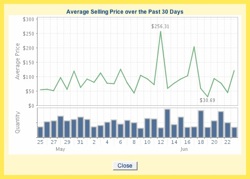 Online shopping and analytics service Mpire announced its first two sponsored buying guides today, a home and garden catalogue sponsored by Zillow and a baby and toddlers guide sponsored by Judy’s Book. Mpire mines data from transactions on eBay, Craigslist, Yahoo and Overstock.com to display price trends and quantities of items searched for. The buying guides are sponsored, stylized displays of that data in particular shopping niches. Unfortunately, I don’t think they work very well.
Online shopping and analytics service Mpire announced its first two sponsored buying guides today, a home and garden catalogue sponsored by Zillow and a baby and toddlers guide sponsored by Judy’s Book. Mpire mines data from transactions on eBay, Craigslist, Yahoo and Overstock.com to display price trends and quantities of items searched for. The buying guides are sponsored, stylized displays of that data in particular shopping niches. Unfortunately, I don’t think they work very well.
Mpire is a 16 person company based in Seattle that just launched this month. The team is interesting. Matt Hulett, Chairman & CEO, used to be the President of the corporate travel division at Expedia. J. Richard Rock, former Senior Director of Business Development at eBay, is a primary investor. Philip Rosedale, Founder and CEO of Linden Lab (the home of Second Life) is an advisor. With a team like that I can imagine that great things are possible.
 I like the price trend graphs that Mpire offers and if I refine my searches enough to exclude accessories related to my search terms then the data looks helpful. These new sponsored buying guides don’t do that though. One highlighted item, for example, is a Weber grill. When I see it in the Mpire catalogue there’s a nice low average price listed, but when I click through I see eBay listings that include grill covers, replacement parts and other things that include the product name in the search results. This makes the average price of the grill itself appear much lower than it actually is.
I like the price trend graphs that Mpire offers and if I refine my searches enough to exclude accessories related to my search terms then the data looks helpful. These new sponsored buying guides don’t do that though. One highlighted item, for example, is a Weber grill. When I see it in the Mpire catalogue there’s a nice low average price listed, but when I click through I see eBay listings that include grill covers, replacement parts and other things that include the product name in the search results. This makes the average price of the grill itself appear much lower than it actually is.
The company says that Mpire provides helpful data on real market value for items bought online. That may be true for some items, but I don’t think it works with these buying guides. In my conversation with the company, Styx concert t-shirts were a favorite example. I imagine that the real market value of obscure items are well delivered by Mpire, but I’m not so sure about the kind of very general search terms highlighted in these sponsored buying guides.
Search results are also dominated by eBay auctions because low prices are what’s prioritized. Craigslist results aren’t integrated in the page, they just have a simple interface for performing your search in Craigslist.
The idea here is a good one and it is useful if I really roll up my sleeves and refine my searches a number of times or if I’m searching for an item that’s relatively straightforward. Trying to fashion a catalogue out of search results is a tough thing to do though. Keeping the interface simple relative to some complicated data is a real challenge as well, I imagine. Overall I like the idea but I think the implementation leaves a fair bit to be desired.